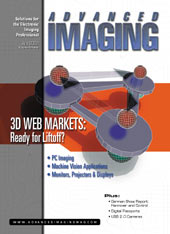
USB 2.0 Cameras:
Setting
the Imaging world on fire!
 |
Silicon
Imaging USB 2.0 Cameras: Setting
the Imaging world on fire! |
The high speed image capture and connectivity market is about
to undergo a revolution. The need for purchasing and installing 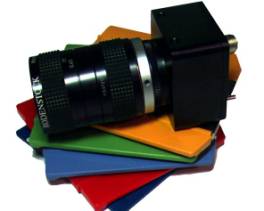 a custom
frame grabber or IEEE-1394 interface card will soon become a distant
memory. The new standard will be to connect your high speed
megapixel machine vision and line scan cameras with a single 4-wire cable
directly into a 480Mbit/sec (megabits per second) USB 2.0 port, soon to be found
in every new motherboard produced with Intel P4 chipsets. These new USB
2.0 vision cameras will transfer precision 8 or 12-bit digital gray scale
or color image data, eliminating the sampling jitter of traditional analog
RS-170 or NTSC systems, at speeds 40x faster than the predecessor USB1.1 and
20% faster than Firewire (aka. IEEE-1394 or Sony i-link) devices. This
interface will also provide bi-directional serial communication for camera
setup and control, triggering, strobing and other I/O signaling. One
of the most convenient benefits, especially for those imaging executives and
sales engineers traveling with the latest lightweight laptops, is not
having to carry an additional power supply; these cameras will be powered
thru the same USB cable. For the vision system end-user, the benefit will
be a lower system cost than previous camera and frame grabber solutions and plug-n-play
installation.
a custom
frame grabber or IEEE-1394 interface card will soon become a distant
memory. The new standard will be to connect your high speed
megapixel machine vision and line scan cameras with a single 4-wire cable
directly into a 480Mbit/sec (megabits per second) USB 2.0 port, soon to be found
in every new motherboard produced with Intel P4 chipsets. These new USB
2.0 vision cameras will transfer precision 8 or 12-bit digital gray scale
or color image data, eliminating the sampling jitter of traditional analog
RS-170 or NTSC systems, at speeds 40x faster than the predecessor USB1.1 and
20% faster than Firewire (aka. IEEE-1394 or Sony i-link) devices. This
interface will also provide bi-directional serial communication for camera
setup and control, triggering, strobing and other I/O signaling. One
of the most convenient benefits, especially for those imaging executives and
sales engineers traveling with the latest lightweight laptops, is not
having to carry an additional power supply; these cameras will be powered
thru the same USB cable. For the vision system end-user, the benefit will
be a lower system cost than previous camera and frame grabber solutions and plug-n-play
installation.
MegaCamera-2.0: See
the light!
The Silicon Imaging MegaCamera-2.0 family offers a broad
range of models based on desired resolution, frame rates, capture method
and cost, each optimized for full USB 2.0 speed performance. All
cameras provide 12bit precision digitizing, sampling rates to 50MHz,
software programmability of exposure, gain, clock, 8/12 bit transfer and
triggering modes, very small size and bus powered capability. The
SI-3200 is the worlds first 3.2 Megapixel USB 2.0 camera, capable of 2048x1536
at 15fps or 1920x1080 HDTV resolution at 24fps. An 8x digital
pan/tilt/zoom function enables a region of the image to be
readout at video rates and moved through the scene for video conferencing
and surveillance applications. For lower cost application the SI-1300
provides 1280x1024 resolution at 30fps. For scientific analysis,
medical imaging and stop-motion machine vision applications the SI-1024F has
1024x1024 resolution up to 30fps with large 12um pixels, Full-Frame
shutter, binning, adaptive readout and windowing. For high speed motion capture
and sports analysis, the SI-320F can capture and recording 320x240 resolution
video at over 500 frames per second. All models are available in either
monochrome or Color RGB Bayer formats with products starting under $995. Yes,
this includes a cable.
USB
Background
 The
Universal Serial Bus (USB) standard was originally developed in 1995, to
minimize the number of ports in the back of the PC. The major goal of USB
was to define an external expansion bus which makes adding peripherals to a PC
low cost and as easy as hooking up a telephone to a wall-jack. USB
featured a maximum bandwidth of 1.5Mbit for low speed devices such as mice and
keyboards, and a maximum bandwidth of 12Mbit for higher speed devices such as
web cams, printers, scanners and external CD-RW drives. Frustrated by
Apples royalty fees on firewire devices, in April 2000, seven industry-leading
companies, consisting of Compaq, Hewlett Packard, Intel, Lucent, Microsoft, NEC,
and Philips published the specifications for USB2.0. It has taken approximately
2 years for USB 2.0 to become adopted as a mainstream USB1.1 replacement.
In just a few short months USB 2.0 will be the high speed PC peripheral
connectivity choice over IEEE-1394.
The
Universal Serial Bus (USB) standard was originally developed in 1995, to
minimize the number of ports in the back of the PC. The major goal of USB
was to define an external expansion bus which makes adding peripherals to a PC
low cost and as easy as hooking up a telephone to a wall-jack. USB
featured a maximum bandwidth of 1.5Mbit for low speed devices such as mice and
keyboards, and a maximum bandwidth of 12Mbit for higher speed devices such as
web cams, printers, scanners and external CD-RW drives. Frustrated by
Apples royalty fees on firewire devices, in April 2000, seven industry-leading
companies, consisting of Compaq, Hewlett Packard, Intel, Lucent, Microsoft, NEC,
and Philips published the specifications for USB2.0. It has taken approximately
2 years for USB 2.0 to become adopted as a mainstream USB1.1 replacement.
In just a few short months USB 2.0 will be the high speed PC peripheral
connectivity choice over IEEE-1394.
Introduction to USB 2.0
 The
USB 2.0 specification extends the maximum speed of the connection from 12 Mbps
on USB 1.1 up to 480 Mbps (60MBytes/sec). This enables the transfer of
1920x1080 images at 24fps (frames per second) for high-definition video
conferencing or 320x240 images at 500fps for high speed video motion analysis.
The transition to USB 2.0 will be seamless, since USB 2.0 is both forward
and backward compatible with USB 1.1. Older peripherals will simply plug
into new USB 2.0 capable PCs and Hubs. The USB connectors and cables are
even identical. It is even possible for a high speed USB 2.0
device to plug into a legacy USB1.1 port and simply operate at reduced
throughput. Both Hi-Speed USB 2.0 and original USB 1.1 peripherals
can operate on a computer at the same time. The new USB 2.0 expansion hub
design manages the transition of the data rates between the high speed host
and lower speed USB peripherals, while maintaining full bandwidth
utilization. Up to 127 USB peripherals with 5 levels of hubs
can be connected to a single USB host controller. With 5 Meters (16.4
feet) of cabling between devices, a network of cameras, sensors, data
acquisition, and I/O devices can physically extend up to 30 Meters (98 feet)
from the PC. A peripheral can either be self-powered or bus-powered,
with up to 500mA of consumption. To satisfy the needs of low-power embedded and
portable computer applications, a power-management mechanism is also
incorporated.
The
USB 2.0 specification extends the maximum speed of the connection from 12 Mbps
on USB 1.1 up to 480 Mbps (60MBytes/sec). This enables the transfer of
1920x1080 images at 24fps (frames per second) for high-definition video
conferencing or 320x240 images at 500fps for high speed video motion analysis.
The transition to USB 2.0 will be seamless, since USB 2.0 is both forward
and backward compatible with USB 1.1. Older peripherals will simply plug
into new USB 2.0 capable PCs and Hubs. The USB connectors and cables are
even identical. It is even possible for a high speed USB 2.0
device to plug into a legacy USB1.1 port and simply operate at reduced
throughput. Both Hi-Speed USB 2.0 and original USB 1.1 peripherals
can operate on a computer at the same time. The new USB 2.0 expansion hub
design manages the transition of the data rates between the high speed host
and lower speed USB peripherals, while maintaining full bandwidth
utilization. Up to 127 USB peripherals with 5 levels of hubs
can be connected to a single USB host controller. With 5 Meters (16.4
feet) of cabling between devices, a network of cameras, sensors, data
acquisition, and I/O devices can physically extend up to 30 Meters (98 feet)
from the PC. A peripheral can either be self-powered or bus-powered,
with up to 500mA of consumption. To satisfy the needs of low-power embedded and
portable computer applications, a power-management mechanism is also
incorporated.
Getting Started -
Enumerate it!
A USB device can be plugged in anytime, even while the PC is
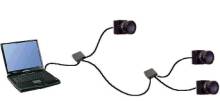 turned on. The installation process is truly
plug-and-play; no hassles with jumpers, IRQ settings, Interrupt or
incorrect drivers. To achieve this almost magical connection process, the
PC and peripheral, in our example the camera, go thru a detailed
electrical handshaking and data setup procedure. A high-speed camera
initially attaches to the PC USB controller as a classic full-speed
(12Mb/sec) device. The camera then signals it is high-speed
capable. The host controller responds to indicate it is also USB 2.0 capable and
begin communicating at the high-speed rate. When the PC operating
system detects that a USB device has been plugged in, it automatically assigns
the peripheral a unique address. All further communication to that device
uses this address, thereby distinguish it from other devices on the bus. The PC
then learns the devices capabilities, by requesting its "descriptors". This
information is stored within the power and bandwidth needs and required
driver. From this information, the PC automatically loads the device’s driver
into the operating system and the device is ready for use. This sign-on process
is called Enumeration.
turned on. The installation process is truly
plug-and-play; no hassles with jumpers, IRQ settings, Interrupt or
incorrect drivers. To achieve this almost magical connection process, the
PC and peripheral, in our example the camera, go thru a detailed
electrical handshaking and data setup procedure. A high-speed camera
initially attaches to the PC USB controller as a classic full-speed
(12Mb/sec) device. The camera then signals it is high-speed
capable. The host controller responds to indicate it is also USB 2.0 capable and
begin communicating at the high-speed rate. When the PC operating
system detects that a USB device has been plugged in, it automatically assigns
the peripheral a unique address. All further communication to that device
uses this address, thereby distinguish it from other devices on the bus. The PC
then learns the devices capabilities, by requesting its "descriptors". This
information is stored within the power and bandwidth needs and required
driver. From this information, the PC automatically loads the device’s driver
into the operating system and the device is ready for use. This sign-on process
is called Enumeration.
USB2.0 Speed throughput
In USB, the PC is the master and the peripherals are
slaves. The PC makes requests and peripherals respond. A typical
USB transaction has three stages. First, a Token packet is sent by the PC
with the address of the device and an indication of the desired direction of
data transfer. If data is being sent to the peripheral, such as camera
setup commands, it is an OUT request. If data will be sent from the
peripheral to the PC, such as image data input from a camera, it is an IN
request. Next is the data packet transfer stage. A data packet
can have up to 3072 bytes along with a CRC value for error checking. The
third stage is the handshake. Once the data has arrived successfully, a
packet is sent to ACK or acknowledge it. For streaming data which do
not require error checking or handshaking, for slightly reduced overhead,
can be sent in isochronous mode. For guaranteed data accuracy, in Bulk
mode, packets with errors are retransmitted. Every 125usec a bus
synchronization signal call Start-of-microframe is issued. During each microframe
the PC will perform multiple data transfers. For maximum bandwidth
utilization, up to 13 packets containing 512 bytes of data can be
transferred during each microframe,. This translates to over 53 Mbytes/sec
throughput (13 packets/uFrame * 512 bytes/packet * 8uFrames/ms), including
protocol and handshake overhead. From the programmers perspective,
Intel sends USB 2.0 into ubiquity
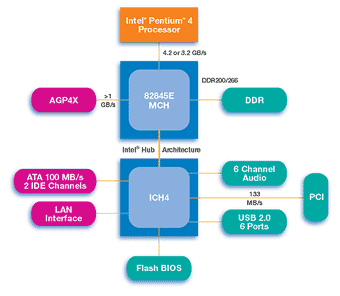
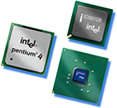 In
May 2002, Intel sealed the success of USB2.0 connectivity. Intel released a family
of chipsets called 845E, 845G and 845GL for both the Pentium-4 and Celeron
processors. These chipsets which include the ICH4 South Bridge
chip, all have an embedded USB2.0 enhanced host controller interface and
hub, capable of supporting up to 6 high or low speed ports. PC
OEMs will no longer need to purchase and incorporate an additional peripheral IC
to implement the interface; it will effectively come for free. Further
accelerating market domination, Intel also released a family of motherboards
based on these new chipsets. The next day after the debut, Dell released
its first desktop machine with this new chipset architecture, the 4300S, with
a retail price of
$789! Yes, that includes
a monitor.
In
May 2002, Intel sealed the success of USB2.0 connectivity. Intel released a family
of chipsets called 845E, 845G and 845GL for both the Pentium-4 and Celeron
processors. These chipsets which include the ICH4 South Bridge
chip, all have an embedded USB2.0 enhanced host controller interface and
hub, capable of supporting up to 6 high or low speed ports. PC
OEMs will no longer need to purchase and incorporate an additional peripheral IC
to implement the interface; it will effectively come for free. Further
accelerating market domination, Intel also released a family of motherboards
based on these new chipsets. The next day after the debut, Dell released
its first desktop machine with this new chipset architecture, the 4300S, with
a retail price of
$789! Yes, that includes
a monitor.
Since the ICH4 connects directly to the memory
controller, (aka. North Bridge chip), over a 266MB/s (32bit/66MHz) hub
interface, it can simultaneously move data from the USB2.0 at maximum rates
without reducing the bandwidth capacity of the 32bit/33MHz PCI bus. For
applications requiring multiple high speed simultaneous capture, additional
USB2.0 PCI adaptor cards can be added into the system without saturating the
bus. This new PC architecture provides the same system improvement for digital
video capture as the AGP bus provided for increased throughputs to a
display. The result is more inputs, speed, resolution, or frame
rate at lower costs.
Microsoft not in the Driver Seat?
Earlier this year, there was some industry buzz that
Microsoft may not be strongly backing the emerging USB2.0 standard, as the
supporting drivers were not included with the launch of WIN-XP. The main
issue was that the USB2.0 drivers were not completed at the time of launch of XP
and there were not enough peripherals on the market yet for testing. The
delay was simply to prevent potential incompatibilities, reminiscent of the
early days of Firewire, and to insure clean installation and operation for the
new generation of peripherals. Microsoft has since released a driver for
Windows XP and has upgrades planned for Windows Me and Windows 2000.
However, Microsoft has stated it will not provide USB 2.0 driver support on
Windows 9x or earlier Windows operating systems. Adaptec, a recognized
leader in USB2.0 Adaptor cards and hubs, has jumped in to fill this
market need by developing and delivering drivers for their USB2.0 host products
for WIN 98, XP, ME and 2000. The Linux community has even recognized the
imminent growth of USB2.0 and has already released driver support in their
latest kernel.
CameraLink still the king of speed
CameraLink, a connectivity standard for industrial digital
cameras and frame grabbers, will continue to be the interface of choice for the
highest speed imaging applications. In its base configuration, CameraLink
can transfer at up to 1.6 Gb/sec. In Full configuration, using 2 cables, the
rate is extended up to 4.8 Gb/sec. This extremely high
throughput has enabled the Silicon Imaging SI-3170 CameraLink camera to achieve
sustained real-time 30fps 12-bit video at 3.2 Megapixel resolution, or 1.2
Gb/sec peak transfer speeds. To meet the increased transmission capacity
of this interface, CameraLink frame grabber manufacturers have recently expanded
their product offerings to include 32bit/66MHz and 64bit/66MHz PCI cards
with multiple channel input capability. At the entry level, 32bit/33MHz PCI
cards provide price/performance value with products starting as low as
$695. No, that does not include the cable.
USB 2.0 versus Firewire IEEE-1394
The primary difference of IEEE-1394 is its peer-to-peer topology, which enables peripherals, such as a VCR and television, to communicate between each other without the need for a master PC. This feature does not provide any value in a system where the PC is doing your image capture, processing, display, storage and networking. The USB Master/Slave architecture was chosen as the best way to keep peripheral costs to a minimum. Silicon vendors estimate that 1394 peripheral controllers require four to five times more gates to implement the interface than a comparable USB 2.0 peripheral. The "smarts" are placed on the PC side, eliminating the costly intelligence required for every USB peripheral device. In addition, USB has remained royalty free, making inexpensive peripherals possible and avoiding the burden of licensing.
|
Category |
USB 2.0 |
IEEE-1394a |
CameraLink |
|
Topology |
Master-slave, OTG |
Peer-to-peer |
Master-slave |
|
Bit rates |
480
Mbits/s |
400
Mbits/s |
1.6
Gbit/s, 4.8 Gbit/s |
|
Transaction intervals |
125 microseconds |
125 microseconds |
Synchronous |
|
Bus
master |
Dedicated |
Allocated
at bus reset |
PC |
|
Signaling |
Current
mode differential |
LVDS,
optical |
Multiplexed
LVDS |
|
Cable
Distance |
5
M, |
4.5
M, |
10M |
|
No.
of Wires |
4 |
6 |
26,
52 |
|
Bus
Power Consumption |
Up
to 500mA @ 5V |
Up
to 1.5A |
no |
|
Licensing |
No |
Licensing
agreement and royalties |
No |
|
Main
applications |
PC-centric |
Consumer
electronics |
PC-centric |
|
Devices
in network |
127 |
63 |
1 |
The base link speed of USB2.0 at 480Mbit/sec is 20% faster
than Firewire's 400Mbit/sec rate. For the past two years, 1394 proponents
would show you a specification for 1394b with supported data rates in excess of
800Mbit/sec. To date, no silicon manufacturer is in production with 1394b
higher data rate devices, primarily due to lack of market demand. When,
and if, these devices are finally introduced to the market, they will have
several strikes against its implementation. First, they will likely be
highly targeted for Disk Drive Interfaces not imaging. Second, the
user will still be required to purchase a custom interface card which will
immediately saturate the PCI bus, leaving no bandwidth for other devices to
communicate. Third, the interface will not achieve the higher
data rates necessary for CameraLink connectivity applications.
USB 2.0 OTG is
On-The-Go
 Due to the growing need for a direct
interconnectivity between mobile devices (e.g. digital cameras, PDA, cell
phones) and computer peripherals (e.g. printers, disk drives, home gateways) the
USB 2.0 specification was recently supplemented with "On-The-Go" (OTG)
capability. With this simple addition, an OTG peripheral will have limited
host type capability and enable direct data transfer, peer-to-peer, to another
USB or OTG peripheral, without PC intervention. This is just another stake in
the heart for IEEE-1394. But for now, both USB 2.0 and 1394 are expected
to co-exist on many consumer systems into the foreseeable future.
Due to the growing need for a direct
interconnectivity between mobile devices (e.g. digital cameras, PDA, cell
phones) and computer peripherals (e.g. printers, disk drives, home gateways) the
USB 2.0 specification was recently supplemented with "On-The-Go" (OTG)
capability. With this simple addition, an OTG peripheral will have limited
host type capability and enable direct data transfer, peer-to-peer, to another
USB or OTG peripheral, without PC intervention. This is just another stake in
the heart for IEEE-1394. But for now, both USB 2.0 and 1394 are expected
to co-exist on many consumer systems into the foreseeable future.
CONCLUSION
With millions of powerful 2.4 to 3.0GHz motherboards
with USB 2.0 built-in to ship this year, with no additional cost to the user,
there is no doubt that USB2.0 will soon become the de-facto standard for vision
cameras and high speed image processing. According to the In-Stat/MDR
report "USB: The Universal Connection," USB 2.0 enabled devices will
gain rapid acceptance in the marketplace with a 220% compound annual growth rate
predicted between 2001 and 2006. USB 2.0 will be the preferred connection
for most PC peripherals, whereas the IEEE 1394 interface will coexist with
USB2.0 in audio/visual consumer electronic devices. The USB2.0 will
achieve faster speeds and lower costs than IEEE-1394. However, CameraLink will continue to be king of speed.
For application requiring direct interconnectivity without a PC, you can
plug in with OTG. A new generation of high performance digital cameras will help
accelerate the adoption of USB2.0 in the imaging and machine vision market.
The result for the system user and instrument developers will be increased
resolutions, higher frame rates, lower costs, smaller size, increased
portability and most likely a new generation of products to offer to offer to
the market.
For more information on the Megacamera2.0, Cameralink and USB2.0 visit www.siliconimaging.com!